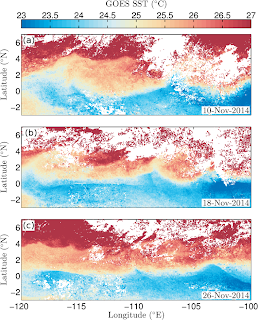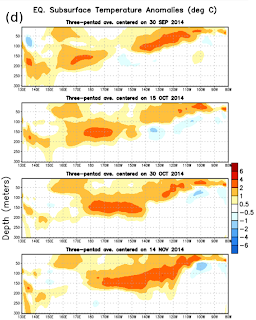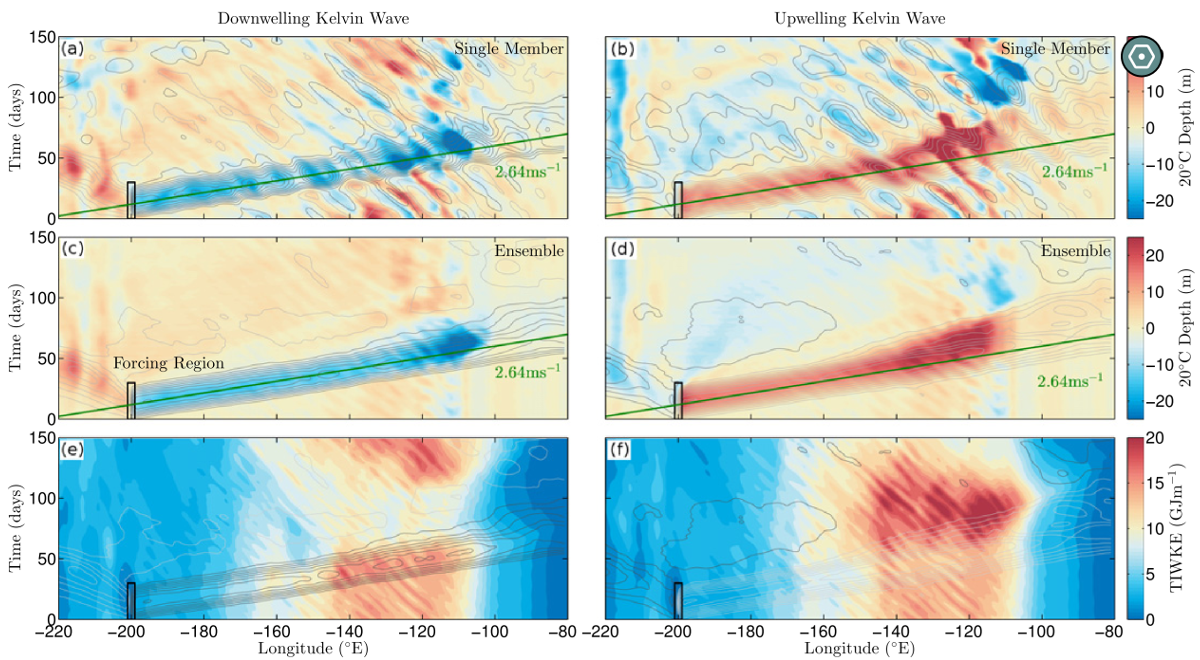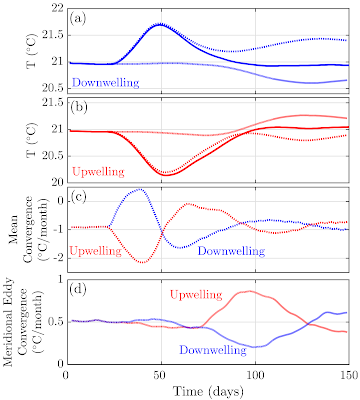Tropical Instability Waves and Kelvin Waves
The rapid decay of the TIW field in late 2014
During a research cruise to the equatorial Pacific in late 2014 on the R/V Oceanus (see abyssal mixing section), we observed an unusual rapid decay in the amplitude and propagation speed of a nearby TIW. Over a period of only 16 days (half the dominant 30-day period of TIWs), the extent of TIW-driven meridional excursions of the NEF reduced dramatically (see Fig. 1a-c). This rapid decay turned out to coincide with the arrival of a downwelling equatorial Kelvin Wave from the western Pacific (see Fig. 1d).


Intraseasonal first-baroclinic mode Kelvin waves
To investigate whether the Kelvin wave was responsible for the changes in TIW amplitude, we decided to run a set of ROMS simulations forced with intraseasonal Kelvin waves. These Kelvin wave experiments were spun off of a statistically-steady spinup simulation forced with constant atmospheric forcing taken from the strong trade-winds (and thus strong TIWs) season. From this steady spinup run, we forced 60-day period upwelling and downwelling Kelvin wave pulses in the western Pacific. These intraseasonal Kelvin waves propagate across to the eastern Pacific driving changes in the thermocline depth, sea surface height (SSH) and zonal currents (see Fig. 2 a, b). To cleanly separate the TIW flow from the Kelvin wave flow, we performed an ensemble of experiments allowing an ensemble average to remove the TIW variability (see FIg. 2 c,d). We found that indeed downwelling Kelvin waves do result in a significant decrease in the amplitude of the TIW field, here measured using the TIW kinetic energy (TIWKE; see Fig. 2e). In contrast, an upwelling Kelvin wave drove a strong intensification of the TIWKE, which peaked roughly 30-days after the Kelvin wave peak (Fig. 2f).

The TIWKE budget
To explain why the Kelvin waves drive changes in the TIWKE, we examined the TIWKE, or EKE, budget described by the following equation:


where K is the TIWKE and the terms on the right-hand-side represent mean advection of TIWKE, pressure (or wave) fluxes of TIWKE, eddy advection of TIWKE, conversion of potential energy to TIWKE, fritional dissipation of TIWKE and shear production of TIWKE respectively. The over-line represents an ensemble average while the prime is a deviation from this average, representing the TIW flow. In the steady spinup run, the TIWKE budget is dominated by a balance between the production of TIWKE through conversion from PE (the w’b’ term) and lateral shear production acting on the meridional shear of zonal velocity (LSP; the u’v’ dU/dy term), dissipation of TIWKE through friction (the u’Fh’ term) and the radiation of waves (the u’P’ pressure flux term).
The Kelvin waves disrupt this balance by altering the background flow (U and V) and the TIW Reynold’s stress terms (u’v’, w’b’ etc.). In particular, a downwelling Kelvin wave reduces the meridional shear, dU/dy, in the region where the TIWs are strong, thereby reducing the LSP. This kicks off a negative feedback where the TIWKE reduces, driving a reduction in the Reynold’s stress u’v’ and thus a further reduction in LSP. This negative feedback continues until the TIWKE sink terms of dissipation and wave radiation adjust to compensate the changes in LSP. For more details please see my Journal of Physical Oceanography article Holmes and Thomas (2016) Modulation of Tropical Instability Wave Intensity by Equatorial Kelvin Waves.
The upper-ocean heat budget
Intraseasonal Kelvin waves are known to be critical ingredients for initiating sustained perturbations in the coupled tropical atmosphere-ocean as part of the El Nino - Southern Oscillation (ENSO). In particular, downwelling Kelvin waves initiated by westerly wind bursts in the western Pacific are known to drive warm SST anomalies in the eastern Pacific through vertical and zonal advection. In our simulations we do indeed see these SST anomalies (Fig. 3 a, b). However, a single downwelling (upwelling) Kelvin wave pulse should drive a net warming (cooling) due to the net displacement of the zonal gradient in SST to the east (west). In our simulations we find that this net SST change is damped by the changes in the TIW meridional heat fluxes (due to the change in TIWKE), which counter the Kelvin wave induced SST anomalies (compare dotted and dashed lines in Fig. 3 a, b). This results has implications for the role of TIWs in the initiation of ENSO events.

For more information, see my article published in the Journal of Physical Oceanography: Modulation of Tropical Instability Wave Intensity by Equatorial Kelvin Waves.
